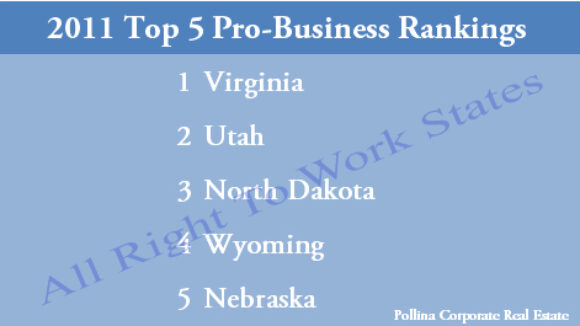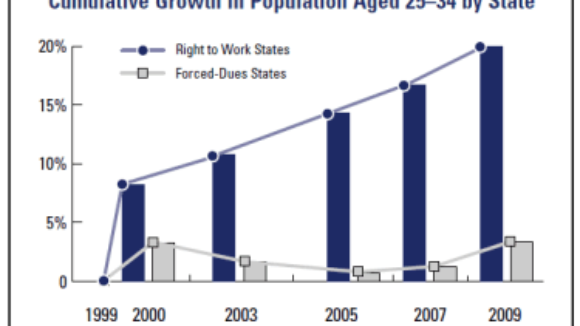Unions Squeeze Workers in Michigan
Despite passage of a Right to Work law, old habits die hard in Michigan as union bosses mislead and lie to their members about whether they can be fired for not paying tribute to the union, News Channel 3 reports:…
Despite passage of a Right to Work law, old habits die hard in Michigan as union bosses mislead and lie to their members about whether they can be fired for not paying tribute to the union, News Channel 3 reports:…
In a column for Bloomberg and Reason magazine’s web site, Shikha Dalmia considers how Big Labor will react to Michigan’s enactment of the 24th state Right to Work law this month: Labor has two options now that its ability to…
James Sherk of the Heritage Foundation confirms what we have known for decades, enacting Right to Work laws create jobs and promote choice for workers: Union contracts frequently require employees to pay union dues or lose their jobs. This forces workers to support the union financially even if the union contract harms them or they oppose the union’s agenda. Several states, including New Hampshire and Indiana, are considering right-to-work laws, which protect workers from being fired for not paying union dues. Unions oppose these laws because they reduce union membership and income. However, the rest of the economy benefits from right-to-work laws. States can and should reduce unemployment by becoming right-to-work states. Right-to-Work Unions often negotiate contracts requiring all workers to pay union dues or lose their jobs, whether or not they support the union. But many workers reject unions. Some do so because union contracts reduce their pay. Others oppose unions’ political agendas: Unions almost exclusively support Democrats, despite 37 percent of their members voting Republican in the last election.[1] To prevent workers from being forced to support unions financially, 22 states have passed right-to-work laws. Such laws prevent companies from firing workers who do not pay union dues. Workers may still pay voluntarily, but unions cannot threaten their jobs if they do not join. Lawmakers in several states, including New Hampshire, Indiana, and Michigan, are considering right-to-work bills. Forced Unionization Is Not an American Value The government should not force workers to pay for unwanted union representation. In a free society, workers alone should make that choice. Right-to-work laws also make good economic sense. They reduce the incentive for union organizers to target companies that treat their workers well. Since unions hurt businesses, less aggressive union organizing attracts investment—and jobs. Lawmakers considering right-to-work proposals should ignore the union movement’s self-interested opposition. Unions could negotiate contracts that apply only to their members—they simply prefer not to. Unions should not be able to force workers to choose between financially supporting them and losing their jobs. Unions Lose Money When Workers Opt Out

From the Richmond Times by NRTW President Mark Mix: Weathering an economic downturn is never easy, but some states are managing better than others. Despite the recession, Virginia boasts a modest unemployment rate, and its average hourly wages top the national mean. What's the Old Dominion's secret? One factor that sets Virginia apart from its less fortunate neighbors is the state's popular Right to Work law. Virginia's Right to Work law ensures that no employee can be forced to join or pay dues to a union just to get or keep a job. Protecting employee choice has always been the most important argument in favor of Right to Work, but Virginia's economic performance is another point for worker freedom. Recent studies from the Cato Institute and the National Institute for Labor Relations Research indicate that right-to-work states enjoy higher job growth and more disposable income (after adjusting for families' cost-of-living) than their forced-unionism counterparts. Eight of the top 11 states for wage and salary growth enjoy right-to-work protections. Meanwhile, 13 of the 14 worst performers lack right-to-work laws. Workers and their families are also voting with their feet: According to the National Institute for Labor Relations Research, the young adult population in forced-unionism states has basically stagnated since 1980. Virginia, on the other hand, continues to attract a stream of new workers and entrepreneurs. Protecting worker freedom also prepares states to handle a difficult recession better than their forced-unionism counterparts. Virginia's robust job and wage growth compares favorably with the sluggish performance of union-dominated states like Michigan, Illinois and Wisconsin.
Sixteen state attorney generals try to stand-up to the Obama NLRB attempt to trample states' rights hours after the NLRB rejected efforts by Boeing employees to be heard. From Associated Press reporter Meg Kinnard: COLUMBIA -- Attorneys general from South Carolina and 15 other states Thursday weighed in on a lawsuit filed by the National Labor Relations Board, alleging that its complaint against Boeing for building an assembly plant in North Charleston after a strike by Washington state workers hurts states' abilities to keep manufacturing jobs. Alan Wilson and Greg Abbott, the attorneys general in South Carolina and Texas, respectively, asserted in a brief that "the NLRB's proposed action will harm the interests of the very unionized workers whom the general counsel's Complaint seeks to protect." "State policymakers should be free to choose to enact right-to-work laws -- or to choose not to enact them -- without worrying about retaliation from the NLRB," the two officials wrote. "It is logical that some employers will simply avoid creating new jobs or facilities in non-right-to-work States in the first place." The brief also was signed by attorneys general in Alabama, Arizona, Colorado, Florida, Georgia, Idaho, Kansas, Michigan, Nebraska, Oklahoma, South Dakota, Utah, Virginia and Wyoming. It points out that the attorneys general represent right-to-work and unionized states, although only two of the signers -- Colorado and Michigan -- fall into the latter category. South Carolina is a right-to-work state where individual employees can join unions voluntarily, but unions cannot force membership across entire worksites.

Matt Mayer of the Buckeye Institute debunks the long-term economic growth without Right To Work freedom is sustainable. Mayer uses a Columbus Dispatch reporter Joe Hatlett column that featured Former Michigan Gov. Jennifer Granholm to expose the fact that corporate welfare and reduced regulations ignore the “proverbial elephant in the room weighing down” compulsory union states like Indiana, Ohio, Illinois,, and Michigan. From Matt Mayer’s post: “With Michigan bleeding jobs and tax revenues, Granholm said she followed the corporate playbook in her attempt to close a huge state budget deficit and make Michigan more competitive. ‘In listening to the business community, I cut takes [sic] 99 times, and I ended shrinking government more than any state in the nation. In my two terms, I cut more by far than any state in the nation. And yet, we still have the highest unemployment rate. There was no correlation.’ Granholm conceded that streamlining business regulations and lowering taxes — Kasich’s economic recovery mantra — are helpful, but they aren’t a panacea…[l]abor costs, help with start-up costs and proximity to markets are other factors.” Hallett and Governor Granholm fail to mention why streamlining regulations and lowering taxes aren’t helping the northern states (located within 50 percent of the U.S. population and with low start-up costs) compete against the southern and western states. Instead, Hallett ignores the obvious answer and pleads for an end to corporate pork (with which we enthusiastically agree). The reason Michigan and Ohio can’t compete is that the southern and western states already have fewer regulations and lower taxes, so “catching up” with those states still leaves the proverbial elephant in the room weighing down the northern states. Plus, those states are also pushing for lower taxes and fewer regulations, so the northern states are perpetually behind them. The elephant, which Governor Granholm does hint at, is labor costs, or, more specifically, unionized labor costs (see: General Motors and the United Auto Workers). As I noted in Six Principles for Fixing Ohio, “Of course, tax and regulatory burdens also impact a state’s economy. Although many of the forced unionization states have heavy tax burdens and many of the worker freedom states have light tax burdens, some heavily taxed worker freedom states (Idaho, Nevada, and Utah) had the strongest sustained job growth from 1990 to today. Similarly, a few moderately taxed forced unionization states still had weak job growth (Indiana, Illinois, and Missouri). The combination of both a heavy tax burden and forced unionization is deadly when it comes to job growth, as 11 of the 15 worst performing states are ranked in the top 20 for high tax burdens.” If Ohio and the other states from Missouri to Maine want to truly compete with Texas, Georgia, and South Carolina, then those states need to enact laws that protect the rights of workers not to join a labor union to get a job.

Matt Mayer of the Buckeye Institute debunks the long-term economic growth without Right To Work freedom is sustainable. Mayer uses a Columbus Dispatch reporter Joe Hatlett column that featured Former Michigan Gov. Jennifer Granholm to expose the fact that corporate welfare and reduced regulations ignore the “proverbial elephant in the room weighing down” compulsory union states like Indiana, Ohio, Illinois,, and Michigan. From Matt Mayer’s post: “With Michigan bleeding jobs and tax revenues, Granholm said she followed the corporate playbook in her attempt to close a huge state budget deficit and make Michigan more competitive. ‘In listening to the business community, I cut takes [sic] 99 times, and I ended shrinking government more than any state in the nation. In my two terms, I cut more by far than any state in the nation. And yet, we still have the highest unemployment rate. There was no correlation.’ Granholm conceded that streamlining business regulations and lowering taxes — Kasich’s economic recovery mantra — are helpful, but they aren’t a panacea…[l]abor costs, help with start-up costs and proximity to markets are other factors.” Hallett and Governor Granholm fail to mention why streamlining regulations and lowering taxes aren’t helping the northern states (located within 50 percent of the U.S. population and with low start-up costs) compete against the southern and western states. Instead, Hallett ignores the obvious answer and pleads for an end to corporate pork (with which we enthusiastically agree). The reason Michigan and Ohio can’t compete is that the southern and western states already have fewer regulations and lower taxes, so “catching up” with those states still leaves the proverbial elephant in the room weighing down the northern states. Plus, those states are also pushing for lower taxes and fewer regulations, so the northern states are perpetually behind them. The elephant, which Governor Granholm does hint at, is labor costs, or, more specifically, unionized labor costs (see: General Motors and the United Auto Workers). As I noted in Six Principles for Fixing Ohio, “Of course, tax and regulatory burdens also impact a state’s economy. Although many of the forced unionization states have heavy tax burdens and many of the worker freedom states have light tax burdens, some heavily taxed worker freedom states (Idaho, Nevada, and Utah) had the strongest sustained job growth from 1990 to today. Similarly, a few moderately taxed forced unionization states still had weak job growth (Indiana, Illinois, and Missouri). The combination of both a heavy tax burden and forced unionization is deadly when it comes to job growth, as 11 of the 15 worst performing states are ranked in the top 20 for high tax burdens.” If Ohio and the other states from Missouri to Maine want to truly compete with Texas, Georgia, and South Carolina, then those states need to enact laws that protect the rights of workers not to join a labor union to get a job.

(Source: March 2011 NRTWC Newsletter) Millions Have 'Voted With Their Feet' For Better Opportunities For a combination of reasons, nationwide the number of young adults aged 25-34 is growing far more slowly than is the number of Americans aged 55 and older. In 1999, according to the U.S. Census Bureau, there were 37.94 million people aged 25-34 living in the U.S. By 2009, there were 41.57 million people nationwide in that age bracket. That's a 9.6% increase. Over the same decade, the number of Americans aged 55 and older soared from 57.93 million to 74.36 million, a whopping 28.4% increase! The nationwide decline in young employees' population share, relative to that of Americans nearing or in their retirement years, is obviously an impediment to economic growth. Eleven Non-Right to Work States Suffered Young-Adult Population Declines
After decades of being under the thumb of the big labor bosses, Michigan in general, and Detroit in particular, are suffering the inevitable consequences. Politicians, often of both parties, let the union bosses run wild in exchange for political support.